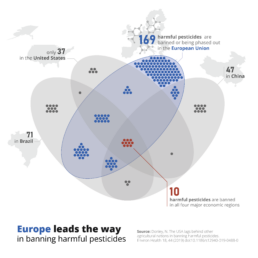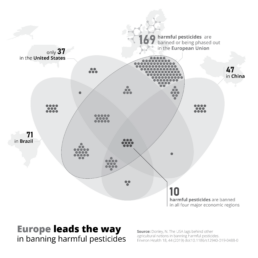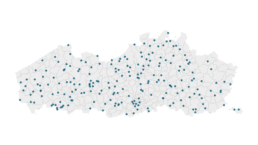Three roles of colour in a data visual
Colour is one of the most crucial tools we have to turn a normal chart into a powerful chart with a clear message, a chart which tells a story rather than simply presenting the information.
This Venn diagram shows the number of harmful pesticides, presented as dots, banned or phased out in four major economic regions (Brazil, the United States, Europe and China).
Notice how colour is used in three different ways here.
Background colours
Grey is used as a background colour– elements in grey are present and visible, but they will never be at the foreground of the visual, or get in the way of the key message. Used in a clever way, grey can help our viewer to distinguish between what’s most and what’s less important, and bring structure to the layout of the visual.
In fact, most of the time it’s a good idea to create the first version of your data visual purely in tints of grey. This will help you to quickly see if your design will work, and how your data visual will be perceived.
Thematic colours
Blue is used as a thematic colour – because we associate the European Union with the colour blue (because of its flag and logo), it is a logical choice to use this colour to indicate everything related to Europe. Blue is not only used for the dots and the Venn diagram, but also the number 169 in the label, and the words ‘Europe’ and ‘European Union’ in the title and label. This helps to tie all the different parts of the image – diagram, title and annotations – together in a logical, visual way.
Accent colours
Finally, red is used as an accent colour – it almost automatically draws our attention to the central part of the visual: the 10 harmful pesticides which are banned in all four major economic regions simultaneously. Make sure to use your accent colours sparingly. As they are so good at drawing attention, using too much of them will quickly overwhelm your audience – they won’t know where to look first! Highlight only the elements which are crucial to explain your key message.
If you want to know more about visualizing data in the right way, you can check out the other videos in this series. Or I invite you to read my book, Powerful Charts, that will give you actionable insights and practical guidelines to create data visuals that truly engage and inspire your audience.
Full video series
- 01. Why is data visualization so powerful?
- 02. Why is data visualization so challenging?
- 03. Navigating the landscape of powerful charts
- 04. A powerful chart tells a story
- 05. A powerful chart has a high signal-to-noise ratio
- 06. Making a data visual noise-free
- 07. 7 different goals for your chart
- 08. Three roles of colour in a data visual
- 09. Choosing the right font for your data visual
- 10. Can you use Excel to create a powerful chart? (coming on January 09, 2023)

Read more:
Vreemde plaatsnamen in Vlaanderen
Iedereen kent wellicht 'Kontich' en 'Reet', maar in Vlaanderen hebben we nog veel meer merkwaardige, onverwachte, en vaak grappige plaatsnamen. Heb je bijvoorbeeld ooit al gehoord van Buitenland, Dikkebus, of Grote Homo?
9 June 2024
Small multiples can save your chart
When you're dealing with a chart that has too much information on it, the most straightforward advice to follow is: break it down into multiple charts, each with less information on them. A powerful example of this is a so-called small multiple approach.
5 September 2023
Data visualization podcasts 2023
At Baryon, we’re huge fans of podcasts! Data visualization podcasts are a great way to stay up to date on the latest trends and techniques in data visualization.
4 September 2023
Can you use Excel to create a powerful chart?
Spreadsheet tools such as Microsoft Excel or Numbers might not be the first thing on your mind when considering data visualization tools, but they can be pretty solid choices to build data visuals. Don’t let anyone convince you that using Excel to create data visuals is unprofessional.
9 January 2023
Choosing the right font for your data visual
Fonts evoke emotions: there are very sophisticated fonts, playful fonts, attention-grabbing fonts, and elegant handwritten fonts. Using the wrong type of font can have a lot of impact. In data visualization the implications of typography are mainly focused on readability. Labels and annotations can easily become so small they get hard to read. Above all else, we should choose a font which is readable at small sizes.
2 January 2023
7 different goals for your chart
A crucial step in building a powerful chart is choosing the right type of chart. A lot of charts don’t work because they simply use the wrong type of chart. To avoid this trap, we must ask ourselves a basic question: what’s the ultimate goal of our data visual? What do we want to show with our data?
19 December 2022
We are really into visual communication!
Every now and then we send out a newsletter with latest work, handpicked inspirational infographics, must-read blog posts, upcoming dates for workshops and presentations, and links to useful tools and tips. Leave your email address here and we’ll add you to our mailing list of awesome people!








